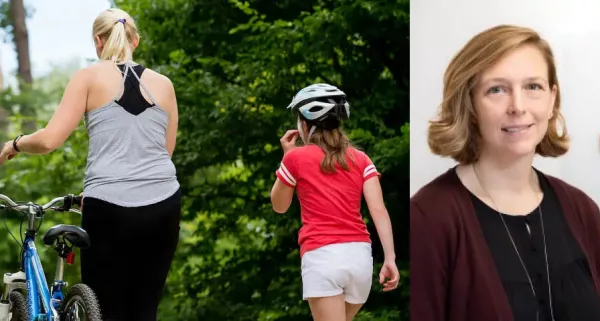Originally published Aug. 23, 2022 by University of Wisconsin-Madison School of Education.
By Laurel White
Middle school girls who don’t play sports but could greatly benefit from the positive mental, physical, and social effects of being active are the targets of a new grant-funded outreach program in the Department of Kinesiology.
The program will connect sixth through eighth-grade girls at two schools in Madison with UW-Madison students and instructors for workouts and activities crafted to appeal to the girls’ interests and aimed at breaking down barriers to physical activity.
 “I’ve been thinking about them as an invisible group of girls,” said Morgan Shields, academic program manager for undergraduate studies in the Department of Kinesiology. “In kinesiology, we think about athletes a lot, we think about people who like physical activity. I wanted to reach out to the gals who stopped playing sports, or never started, and create a space for them to just learn and try stuff out in a safe environment with really strong mentors and theory-based information.”
“I’ve been thinking about them as an invisible group of girls,” said Morgan Shields, academic program manager for undergraduate studies in the Department of Kinesiology. “In kinesiology, we think about athletes a lot, we think about people who like physical activity. I wanted to reach out to the gals who stopped playing sports, or never started, and create a space for them to just learn and try stuff out in a safe environment with really strong mentors and theory-based information.”
Shields, a lifelong athlete and former UW-Madison volleyball player, received a grant to launch the program from the school’s Virginia Horne Henry Fund. The fund is dedicated to supporting activities — from research to student recreation programs — related to women’s physical education, movement, and the female body in culture.
“My passion is girls’ and women’s health — mental health, specifically — and years of reading, teaching, and observing led me to launching this program,” Shields said. “It’s really just to help increase their enjoyment and awareness of physical activity so that, as they move through life, it’s another tool they can use to be healthier.”
The program has already surveyed more than 200 middle school girls at two Madison schools. The schools were targeted, in part, because of their high enrollment in free and reduced-cost lunch programs.
The surveys asked the girls what kinds of activities they already enjoy and what they like learning about. A team of undergraduate research assistants are logging the survey responses, which will be used to craft workouts and activities that appeal to the girls’ interests. For lovers of geography, Shields imagines working maps into the workout. For science aficionados, she envisions an activity that would involve jumping and a quick lesson about bone density.
“I don’t know what the program looks like yet,” Shields said. “I want the girls to tell me what they like.”
Eventually, Shields said she and her team will apply for more funding to provide additional resources for the program, from sports equipment to sports bras and transportation for the girls, if needed. Her goal is for the program to be piloted at the two Madison schools next spring.
After that, she wants to expand to more schools, perhaps even creating a manual for others who want to launch similar programs, and imagines the outreach becoming a permanent fixture in the Department of Kinesiology. She sees it as a way for students studying in fields like health promotion and health equity, kinesiology, and physical education to use their skills, passion, and expertise to engage and enrich the lives of girls in the community.
It isn’t lost on Shields that the program is rolling out just in time for the 50th anniversary of Title IX, the federal civil rights law that prevents discrimination based on sex in public education programs. Even after 50 years of Title IX, Shields believes there’s a long way to go toward clearing a path for girls to engage with and enjoy physical activity.
“We can do better,” she said. “There’s gender disparity in physical activity and sports — and who’s going to fix it?”


